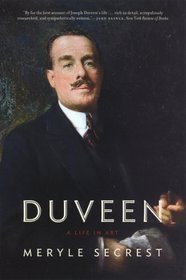Search -
Duveen : A Life in Art
Duveen A Life in Art
Author:
Anyone who has admired Gainsborough's Blue Boy of the Huntington Collection in California, or Rembrandt's Aristotle Contemplating the Bust of Homer at the Metropolitan Museum of Art in New York owes much of his or her pleasure to art dealer Joseph Duveen (1869–1939). Regarded as the most influential—or, in some circles,... more »
Author:
Anyone who has admired Gainsborough's Blue Boy of the Huntington Collection in California, or Rembrandt's Aristotle Contemplating the Bust of Homer at the Metropolitan Museum of Art in New York owes much of his or her pleasure to art dealer Joseph Duveen (1869–1939). Regarded as the most influential—or, in some circles,... more »
ISBN-13: 9780226744155
ISBN-10: 0226744159
Publication Date: 11/1/2005
Pages: 540
Rating: ?
ISBN-10: 0226744159
Publication Date: 11/1/2005
Pages: 540
Rating: ?
0 stars, based on 0 rating
Publisher: University Of Chicago Press
Book Type: Paperback
Other Versions: Hardcover
Members Wishing: 1
Reviews: Amazon | Write a Review
Book Type: Paperback
Other Versions: Hardcover
Members Wishing: 1
Reviews: Amazon | Write a Review
Genres:
- Arts & Photography >> Individual Artists >> General
- Arts & Photography >> Art >> Instruction & Reference >> Business of Art
- Biographies & Memoirs >> Arts & Literature >> Artists, Architects & Photographers
- Biographies & Memoirs >> General




